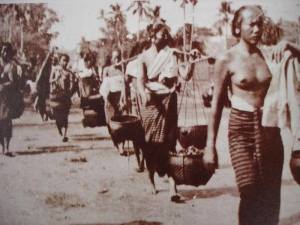Every once in a while over the past decade or so, the issue of how women, particularly young women, dress gets discussed in the Thai media. These debates often start with a comment made by a politician or a public figure, they rage for a while and then disappear, only to resurface again after a period of time.
Since the late 1990s one debate has been over “spaghetti strap” tops (i.e., tops with thin straps, or tops that have no straps at all.
In writing about once instance of public debate over this issue in 1999, Professor Chalidaporn Songsamphan has noted that, “The media depicted this fad as another symptom of moral decline in society. These styles of dressing were perceived as inappropriate for Thai women, young and old alike, since they exposed too much of women’s bodies.”
What is ironic about this critique, Professor Chalidaporn points out, is that leaving ones shoulders uncovered is actually a very “traditional Thai” way of dressing.
As Professor Chalidaporn explains, up until the early twentieth century many women wrapped their breasts with a piece of cotton cloth, leaving their shoulders bare. Or in the case of areas like what is today northern Thailand, some women did not even cover their breasts, but instead simple hung a scarf around their necks.
Professor Chalidaporn goes on to point out, “The well-covered clothes came to this society with the wave of colonialism during the Victorian era.” And therefore, what some Thai have defended in recent years as the “traditional” way for Thai women to dress is actually, Professor Chalidaporn explains, “very Western or non-Thai.”
[Chalidaporn Songsamphan, “Political and Gender Power Relations: Contemporary Discourses on Sexuality in Thai Society,” in Women’s Studies in Thailand: Power, Knowledge, and Justice, ed., Suwanna Satha-anand (Seoul: Ewha Women’s University Press, 2004), 171-72.]
While all of what Professor Chalidaporn states is true, I came across something in a newspaper from 1935 recently that adds to the complexity of this issue. In particular, I found the following picture and text on the front page of the 25 August 1935 issue of the Siam Rashdra Daily News:
The text says that “modern girls” (saaw samay) should try wearing this sleeveless outfit. It notes that it fits perfectly the area around the breasts, and that this type of top is very well suited for “hot countries like ours.”
I’m not sure if whoever put this picture in the paper was actually serious about thinking that Thai women should dress like this, or if he (and I’m sure it was a man) just wanted an excuse to put an enticing picture of a beautiful woman in the paper.
Regardless of that, however, this picture and text do point to the fact that the discussion about what kind of clothing is appropriate for Thai women has really been going on for over a century. Yes, it began when some members of the elite adopted Victorian mores of dress in the late nineteenth century, but not long after this picture was published there was another major effort to “modernize” Thai clothing (by “Westernizing” it) during the period of Field Marshal Plaek Phibunsongkhram’s rule in the late 1930s-early 1940s.
One of the results of all of this is that by the late twentieth century an imagined idea of what “traditional” Thai dress must have been like had emerged, and this idea is at work in the debates over clothes like spaghetti-strap tops.
To be fair, the way that “traditional” women’s dress is represented (in various media) in Thailand today can allow for shoulders to be bared. But I would argue that this is only possible because the women who dress this way are depicted as maintaining all of the “proper traditional mores.”
They can reveal their shoulders because they are “good” girls who embrace the “traditional morality” of Thai culture. But as for those young kids today running around in spaghetti-strap tops. . . they are a problem.
After all, Thailand is still a “hot country,” and for “traditional” Thai morality to endure, people have to remain “cool.”




I can see a good connection between this post and your last post on SEA scholars and SEA Studies, particularly in relation to your critique of the effort to look for the authenticity of SEA among many SEA scholars. This new post offers a great example to challenge and complicate what constitutes ‘Thai tradition’.
Just to clarify, the idea of “Thai-ness” has been critiqued and deconstructed a lot by now. What I say here is just another detail.
And to be fair to the scholars in the book “Decentring SEAsian Studies,” I don’t think they are looking for “authenticity.” That is something that I have noticed among other people.
Thanks, and sorry that I’ve overlooked these details.
No need to apologize. I wrote that post more or less from memory. I then went back and looked at the book again. It’s quite “slippery” as it acknowledges various ideas (like Chen Kuan-hsing’s in Asia as Method) but doesn’t take a clear stand regarding them. So I find that it leaves me with a “feeling” more than with “ideas.” So I can understand why you wrote a long response, as there is a lot to talk about.
Yes. I did realise the dichotomy when i watch Thai historical movies and dramas with the ladies bare shouldered or with just a shawl over their bosoms. I found it strange. But u have now put a light on the subject…